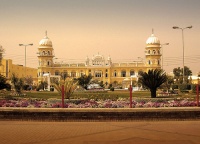Template:AOW281: Difference between revisions
Hari singh (talk | contribs) (Created page with '{{aowh|Gurdwara Janam Asthan}} thumb|right|200px '''Gurdwara Janam Asthaan''' the shrine representing the home of Mehta Kalyan Dass and [[Mata…') |
Hari singh (talk | contribs) No edit summary |
||
| Line 2: | Line 2: | ||
[[Image:Janamasthaan.jpg|thumb|right|200px]] | [[Image:Janamasthaan.jpg|thumb|right|200px]] | ||
'''Gurdwara Janam Asthaan''' the shrine representing the home of [[Mehta Kalyan Dass]] and [[Mata Tripta]], father and mother respectively of [[Guru Nanak Dev]], where the Guru was born, was established by Baba Dharam Chand (1523-1618) son of [[Baba Lakhmi Das]] and grandson of Guru Nanak Dev. | '''[[Gurdwara Janam Asthaan]]''' the shrine representing the home of [[Mehta Kalyan Dass]] and [[Mata Tripta]], father and mother respectively of [[Guru Nanak Dev]], where the Guru was born, was established by Baba Dharam Chand (1523-1618) son of [[Baba Lakhmi Das]] and grandson of Guru Nanak Dev. The shrine is located in the holy city of [[Nankana Sahib]], [[West Punjab]], [[Pakistan]]. | ||
The shrine must have been established before the end of the sixteenth century because [[Guru Arjan Dev]] (1563-1606) is believed to have visited it. Its present building comprising a square, domed sanctum with a rectangular pavilion attached to it within a vast walled compound was built by [[Maharaja Ranjit Singh]]. | The shrine must have been established before the end of the sixteenth century because [[Guru Arjan Dev]] (1563-1606) is believed to have visited it. Its present building comprising a square, domed sanctum with a rectangular pavilion attached to it within a vast walled compound was built by [[Maharaja Ranjit Singh]]. | ||
It is believed that a room was first built here by the Guru's son, [[Baba Lakhmi Das]] (1497-1555) but it is more probably that this was built by his grandson, Baba Dharam Chand (1523-1618). The initial building was known as "Kalu ka Kotha", literally meaning the "house of (Mehta) Kalu", father of Guru Nanak. Later it came to be known as "Nanakayan", literally "home of (Guru) Nanak".<!--- | |||
[[Maharaja Ranjit Singh]] (1780-1839), at the instance of [[Akali Phula Singh]] and Baba Sahib Singh Bedi, constructed the present building, a domed square sanctum with a pavilion in front standing on a spacious, raised platform, and made an endowment of about 20,000 acres of land for the maintenance of [[Guru ka Langar]].---> {{aowf|Gurdwara Janam Asthan}} | |||
Revision as of 10:53, 22 December 2009
Gurdwara Janam Asthaan the shrine representing the home of Mehta Kalyan Dass and Mata Tripta, father and mother respectively of Guru Nanak Dev, where the Guru was born, was established by Baba Dharam Chand (1523-1618) son of Baba Lakhmi Das and grandson of Guru Nanak Dev. The shrine is located in the holy city of Nankana Sahib, West Punjab, Pakistan.
The shrine must have been established before the end of the sixteenth century because Guru Arjan Dev (1563-1606) is believed to have visited it. Its present building comprising a square, domed sanctum with a rectangular pavilion attached to it within a vast walled compound was built by Maharaja Ranjit Singh.
It is believed that a room was first built here by the Guru's son, Baba Lakhmi Das (1497-1555) but it is more probably that this was built by his grandson, Baba Dharam Chand (1523-1618). The initial building was known as "Kalu ka Kotha", literally meaning the "house of (Mehta) Kalu", father of Guru Nanak. Later it came to be known as "Nanakayan", literally "home of (Guru) Nanak". .....More

